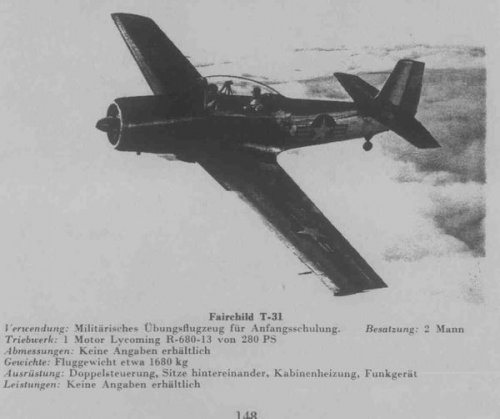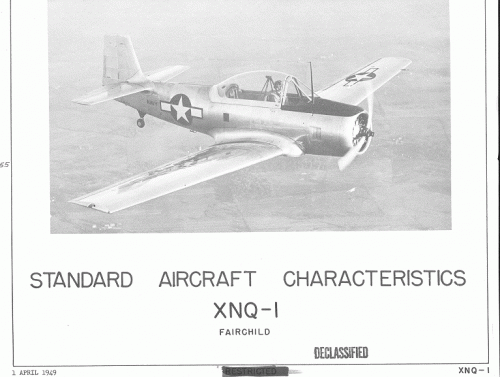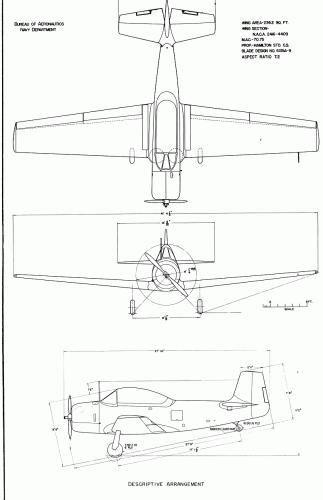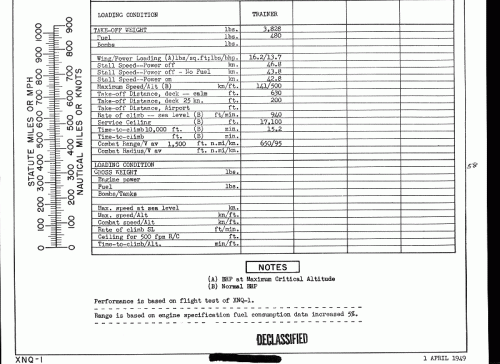FAIRCHILD T-31
As mentioned earlier, the T-31 started out as the Navy XNQ-1, being the winner of a design competition for a primary-basic trainer sponsored by the Bureau of Aeronautics. Invitations to bid were also extended to Beech, Boeing, Bell, Convair, Curtiss-Wright, McDonnell, and North American. As a matter of record, the Navy XNQ-1 prototype was first flown as far back as October, 1946, flight evaluation tests being conducted by the Navy throughout the following year. Although no production contract resulted on the naval side, the Air Force became interested in it as a primary trainer and further flight tests were continued at Wright Field last year. Early this year Fairchild received an $8,000,000 U.S.A.F. contract for 100 aircraft plus spares, and primary flight training on T-31s will commence early next year.
A study of the T-31 shows a conventional, square-cut, low-wing tandem two-seater in the 300 h.p. class, with a tailwheel landing gear configuration, large one-piece bubble canopy, externally hinged slotted trailing-edge flaps, and stressed-skin construction throughout—except for the control surfaces, which are fabric-covered. Illogically, perhaps, from the standpoint of lateral control effectiveness, the ailerons are not slotted, although they appear to have a modest degree of nose balance. Only the main wheels, are retractable, folding inboard into housings forward of the front spar at the junction of the wing with the fuselage, the retraction mechanism being electrically operated.
The engine is a Lycoming R-680-13 nine-cylinder radial with a normal rating of 280 h.p. and 295 h.p. for take-off. Engine cooling air and exhaust gas are taken out through lauvred grilles around the sides and bottom of the cowling, leaving the top cowl panel flush and the windshield unobstructed by oil smudge. The Hamilton-Standard constant-speed airscrew has the blade roots neatly faired off with a fair-sized hub spinner. This latter refinement is conspicuously absent from the T-28, where its effect on blade efficiency might have been considered even more beneficial.
Undoubtedly the most advanced design feature of the T-31 is the functional layout of the cockpits, wherein the characteristic shape of the aircraft part or unit (e.g., wing flaps, landing gear, etc.) is reflected in the shape of the corresponding control-handle in the cockpit; thus, the flap lever handle is shaped like an aerofoil element, the landing gear retraction level knob is patterned after a wheel and tyre, and so on. Engine controls are grouped on the left side and all the electrical switches are neatly ranked on a console on the right. The radio equipment is also neatly tucked away on the right side. Instruments are illuminated by indirect red lighting for night flying, with the flight instruments arranged in the centre of the panel, enclosed by a white boundary-line, and the other instruments grouped around them.
Power Plant
Engine : Lycoming R-680-13 nine-cylinder radial ; normal rating (s.l.) 280 h.p. at 2,200 r.p.m. ; take-off power (s.l.), 295 h.p. at 2.300 r.p.m.
Airscrew : Hamilton-Standard, constant-speed, two-bladed, 8ft 3in diameter.
Tankage : fuel, 80 U.S. gal (wing tanks) ; oil, 6 U.S. gal.
Dimensions
Spin 41ft 5in ; length 27ft 11in ; height 8ft 9in ; landing gear track 9ft I in ; wing area 236 sq ft ; aspect ratio 7.25.
Weights and Loadings
Gross weight 3,750 lb ; weight empty 2,817 lb : useful load 933 lb (instructor and pupil, 400 lb, fuel 480 lb, oil 53 lb); wing loading 15.9 lb/sq ft ; power loading 12.7 lb/h.p.
Performance
Stalling speed (3,500 lb) 56 m.p.h. ; cruising speed (65 per cent normal power) 142 m.p.h. ; maximum speed (s.l.) 166 m.p.h. ; initial climb 1,070ft/min ; service ceiling 19,500ft ; take-off run (over 50ft obstacle) 1,190ft; maximum range 900 miles at 110 m.p.h. ; endurance 4.7 hours at 142 m.p.h.




